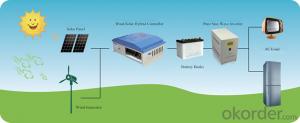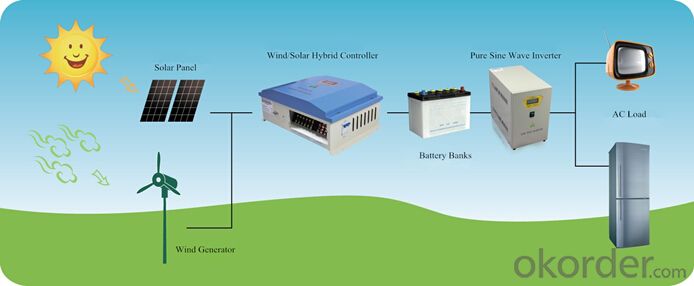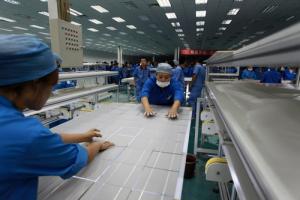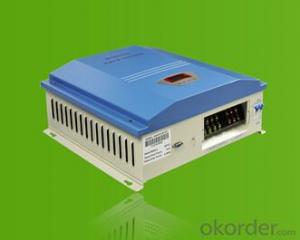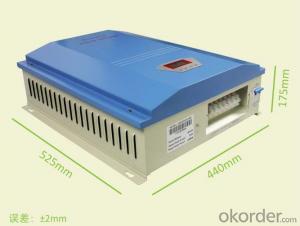Controller 5KW Wind Solar Hybrid PWM Stepless Unload Mode
- Loading Port:
- Shanghai
- Payment Terms:
- TT or LC
- Min Order Qty:
- 1 unit
- Supply Capability:
- 5000 unit/month
OKorder Service Pledge
OKorder Financial Service
You Might Also Like
I. PRODUCT INTRODUCTION
The wind/solar hybrid controller is control device which can control wind turbine and solar panel at the same time and transform wind and solar energy into electricity then store to the battery bank. Wind/solar hybrid controller is the most important part in off-grid system, whose performance has much effect on life expectancy and operational stability of the whole system, especially the battery expectancy. Or battery service life will be shortened by over-charge or over-discharge.
II. PERFORMANCE FEATURES
Superior military-grade components to ensure the product stability.
Perfect protection function, thus the system has higher reliability.
Check and set all operation parameters as requirement from LCD display.
Voltage limiting and current-limiting charge mode ensures battery in the best charging status.
PWM stepless unload mode, which burn the excess power into dump load, making the battery charging in best status.
III. APPLICATION AREAS
Stand alone wind/solar hybrid power station; Stand alone domestic household wind/solar hybrid power system.
Mobile communication base stations, expressway and other non-residential regions.
Coastal islands, remote mountainous, border posts for regions shortage of or without electricity.
Government demonstration projects, landscape lighting project.
IV. 5KW TECHNICAL PARAMETERS
Product Model | WWS50-48 | WWS50-96 | WWS50-120 | WWS50-220 | WWS50-240 |
Rated Battery Voltage | 48V | 96V | 120V | 220V | 240 |
Rated Wind Turbine Input Power | 5kW | 5kW | 5kW | 5kW | 5kW |
Maximum Wind Turbine Input Power | 7.5kW | 7.5kW | 7.5kW | 7.5kW | 7.5kW |
Wind Turbine Brake Current | 105A | 52A | 42A | 23A | 21A |
Rated Solar Input Power | 1.5kW | 1.5kW | 1.5kW | 1.5kW | 1.5kW |
Floating Charging Voltage | 58V | 116V | 145V | 266V | 290V |
Dimension (L x W x H) | Control Box:440×305×170 mm, Dumpload Box:770×390×180 mm | ||||
Net Weight | Control Box:7.5 kg, Dumpload Box:17 kg | ||||
Display Mode | LCD | ||||
Cooling | Fan | ||||
Protection Level | IP20(Indoor) | ||||
Quiescent Current | ≤20 mA | ||||
Protection Functions | Battery over charge; Battery over discharge; solar reverse charge protection; anti-reverse-connection protection; wind turbine over rotate speed protection; wind turbine over wind speed protection; wind turbine over voltage protection; wind turbine over current protection; manual brake protection; automatically brake protection; lightning protection. | ||||
Ambient temperature | -20~+55℃ | ||||
Ambient Humidity | 0~93%, without condensing | ||||
Working Altitude | ≤4000m | ||||
In order to serve our customers better. Our company can adjust parameters configuration according to customer’s requirement. | |||||

- Q: How do PWM solar controllers differ from MPPT solar controllers?
- PWM (Pulse Width Modulation) solar controllers and MPPT (Maximum Power Point Tracking) solar controllers are two different types of charge controllers used in solar power systems. The main difference between PWM and MPPT controllers lies in their charging algorithms and efficiency. PWM controllers regulate the voltage output from the solar panels by rapidly switching the panels on and off. They work by maintaining a fixed voltage output, which can be less efficient when the solar panel's voltage is not perfectly matched with the battery's voltage. Therefore, PWM controllers are suitable for small-scale solar systems or when the solar panel and battery voltages are closely matched. On the other hand, MPPT controllers are more advanced and efficient. They actively track the maximum power point (MPP) of the solar panels by continuously adjusting the operating voltage and current to ensure the maximum power is extracted from the panels. This allows MPPT controllers to operate at higher voltages, reducing the current and power loss during transmission, and maximizing the overall system efficiency. MPPT controllers are particularly advantageous in larger solar systems or when there is a significant mismatch between the solar panel and battery voltages. In summary, PWM solar controllers are simpler and suitable for smaller systems, while MPPT solar controllers are more efficient and better suited for larger systems or when there is a voltage mismatch between the solar panels and batteries.
- Q: Can a solar controller be used in a solar-powered charging station?
- Yes, a solar controller can be used in a solar-powered charging station. A solar controller regulates the flow of electricity from the solar panels to the batteries, ensuring optimal charging and preventing overcharging. In a solar-powered charging station, the solar controller would play a vital role in managing the charging process and maximizing the efficiency of the system.
- Q: Can a solar controller be used with different types of solar tracking systems?
- Yes, a solar controller can be used with different types of solar tracking systems. A solar controller is responsible for managing the charge and discharge of batteries in a solar power system, as well as regulating the power flow between the solar panels and the batteries. It ensures that the solar panels are operating at their optimal efficiency and the batteries are being charged correctly. Solar tracking systems are designed to orient solar panels towards the sun, maximizing their exposure and energy generation. There are different types of solar tracking systems, such as single-axis and dual-axis trackers, which vary in their ability to track the sun's movement. A solar controller can be integrated with any type of solar tracking system as long as it is compatible with the system's specifications and requirements. It needs to be able to communicate and receive input from the tracking system to adjust the solar panel's orientation accordingly. Additionally, the solar controller should have the capability to handle the increased power output and fluctuations that may occur due to the movement of the solar panels. By using a solar controller with a tracking system, the overall efficiency and performance of the solar power system can be enhanced. The controller ensures that the batteries are being charged properly, preventing overcharging or undercharging, while also optimizing the power flow between the solar panels and the batteries.
- Q: What is the maximum temperature that a solar controller can withstand?
- Typically, the specific model and manufacturer determine the maximum temperature that a solar controller can endure. Nevertheless, most solar controllers are capable of withstanding temperatures between -20°C (-4°F) and 60°C (140°F). To ascertain the maximum temperature tolerance of a particular solar controller, it is crucial to refer to the manufacturer's specifications.
- Q: Can a solar controller be used with solar-powered indoor greenhouses?
- Yes, a solar controller can be used with solar-powered indoor greenhouses. A solar controller is designed to regulate and optimize the charging and discharging of batteries in solar-powered systems. It is essential for managing the power generated by solar panels and ensuring proper functioning of the greenhouse.
- Q: What are the signs of a faulty solar controller?
- Some signs of a faulty solar controller include inconsistent or incorrect readings on the controller display, failure to charge the battery properly, irregular or no power output from the solar panels, overheating of the controller, and unusual noises or smells coming from the controller.
- Q: How do I determine the appropriate size of a solar controller for my system?
- To determine the appropriate size of a solar controller for your system, you need to consider the maximum current and voltage your solar panels can generate. Calculate the total current output of your panels and ensure that the solar controller you choose can handle this amount. Additionally, check the maximum input voltage of your panels and select a controller with a higher voltage rating to accommodate any fluctuations. It's always advisable to consult with a professional or refer to the manufacturer's specifications for accurate sizing.
- Q: What is the purpose of a solar controller in a solar power system?
- The purpose of a solar controller in a solar power system is to regulate and control the flow of electricity between the solar panels and the batteries. It ensures that the batteries are charged efficiently and prevents overcharging, which can damage the batteries. Additionally, the solar controller also protects the batteries from discharging too much during periods of low sunlight, extending their lifespan.
- Q: Solar controller use
- The biggest use of solar controllers is to protect the battery
- Q: How do you install a solar controller?
- To install a solar controller, start by identifying the appropriate location near the solar panels. Mount the controller securely to a wall or any suitable surface. Connect the solar panels to the controller's input terminals, ensuring proper polarity. Then, connect the battery to the controller's output terminals, again ensuring correct polarity. Finally, connect any additional components such as load terminals or temperature sensors, if required. Double-check all connections, and follow the manufacturer's instructions for any specific setup or programming steps.
Send your message to us
Controller 5KW Wind Solar Hybrid PWM Stepless Unload Mode
- Loading Port:
- Shanghai
- Payment Terms:
- TT or LC
- Min Order Qty:
- 1 unit
- Supply Capability:
- 5000 unit/month
OKorder Service Pledge
OKorder Financial Service
Similar products
Hot products
Hot Searches
Related keywords


